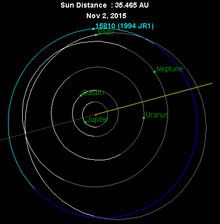Discovered by M. J. IrwinA. Żytkow Alternative names 1994 JR1 Discovered 12 May 1994 Orbits Sun | Discovery date 12 May 1994 Pronunciation /ˈɑr aʊn/ (ahr-oun) Orbital period 246 years Absolute magnitude 7.6 | |
 | ||
Discoverers Anna N. Żytkow, Mike Irwin Similar Sun, (15788) 1993 SB, 2014 MU69, 53311 Deucalion, 38083 Rhadamanthus | ||
15810 Arawn (AHR-oun), provisional designation 1994 JR1, is a trans-Neptunian object (TNO) from the inner regions of the Kuiper belt, approximately 133 kilometres (83 mi) in diameter. It belongs to the plutinos, the largest class of resonant TNOs. It was named after Arawn, the ruler of the Celtic underworld, and discovered on 12 May 1994, by astronomers Michael Irwin and Anna Żytkow with the 2.5-metre Isaac Newton Telescope at La Palma Observatory in the Canary Islands, Spain.
Contents
- Orbit and physical properties
- Quasi satellite dynamical state and orbital evolution
- Origin
- Observation
- References
Arawn is unique in that it has been observed at a much closer distance than most Kuiper belt objects, by the New Horizons spacecraft, which imaged it a distance of 111 million km (69 million mi; 0.74 AU) in April 2016; this and its other observations have allowed its rotation period to be determined.
Orbit and physical properties
This minor planet is moving in a relatively eccentric orbit entirely beyond the orbit of Neptune. With a semi-major axis of 39.4 AU, it orbits the Sun once every 247 years and 6 months (90,409 days). Its orbit has perihelion (closest approach to the Sun) of 34.7 AU, an aphelion (farthest distance from the Sun) of 44.1 AU, an eccentricity of 0.12 and an inclination of 4° with respect to the ecliptic. It is a plutino, so it is trapped in a 2:3 mean motion resonance with Neptune, similarly to dwarf planet Pluto, the largest known plutino.
It measures approximately 133 km (83 mi) in diameter, based on an absolute magnitude of 7.6, and estimated albedo of 0.1. In April 2016, a rotation period of 5.4 hours was determined for this minor planet.
Quasi-satellite dynamical state and orbital evolution
In 2012, Arawn was hypothesized to be in a quasi-satellite loop around Pluto, as part of a recurring pattern, becoming a Plutonian quasi-satellite every 2 Myr and remaining in that phase for nearly 350,000 years. Measurements made by the New Horizons probe in 2015 made it possible to calculate the motion of Arawn much more accurately. These calculations confirm the general dynamics described in the hypotheses. However, it is not agreed upon among astronomers whether Arawn should be classified as a quasi-satellite of Pluto based on this motion, since its orbit is primarily controlled by Neptune with only occasional smaller perturbations caused by Pluto.
Origin
Arawn is moving in a very stable orbit, likely as stable as Pluto's. This suggests that it may be a primordial plutino formed around the same time Pluto itself and Charon came into existence. It is unlikely to be relatively recent debris originated in collisions within Pluto's system or a captured object.
Observation
Arawn is currently relatively close to Pluto. In 2017, it will be only 2.7 AU from Pluto. Before 2014 MU69 was discovered in 2014, Arawn was the best known target for a flyby by the New Horizons spacecraft after its Pluto flyby in 2015.
Arawn was one of the first objects targeted for distant observations by New Horizons, which were taken on 2 November 2015. More observations were made in April 2016.
On 2 November 2015, Arawn was imaged by the LORRI instrument aboard New Horizons, making it the closest observation of a Kuiper belt object other than the Pluto-Charon system by a factor of 15.
Between 7–8 April 2016, New Horizons imaged Arawn from a new record distance of about 111 million kilometers, using the LORRI instrument. The new images allowed the science team at Southwest Research Institute (SwRI) in Boulder, Colorado, to further pinpoint the location of Arawn to within 1000 kilometers. The new data also made it possible for scientists to observe 1994 JR1's rotation period, which was determined to be 5.4 hours.
